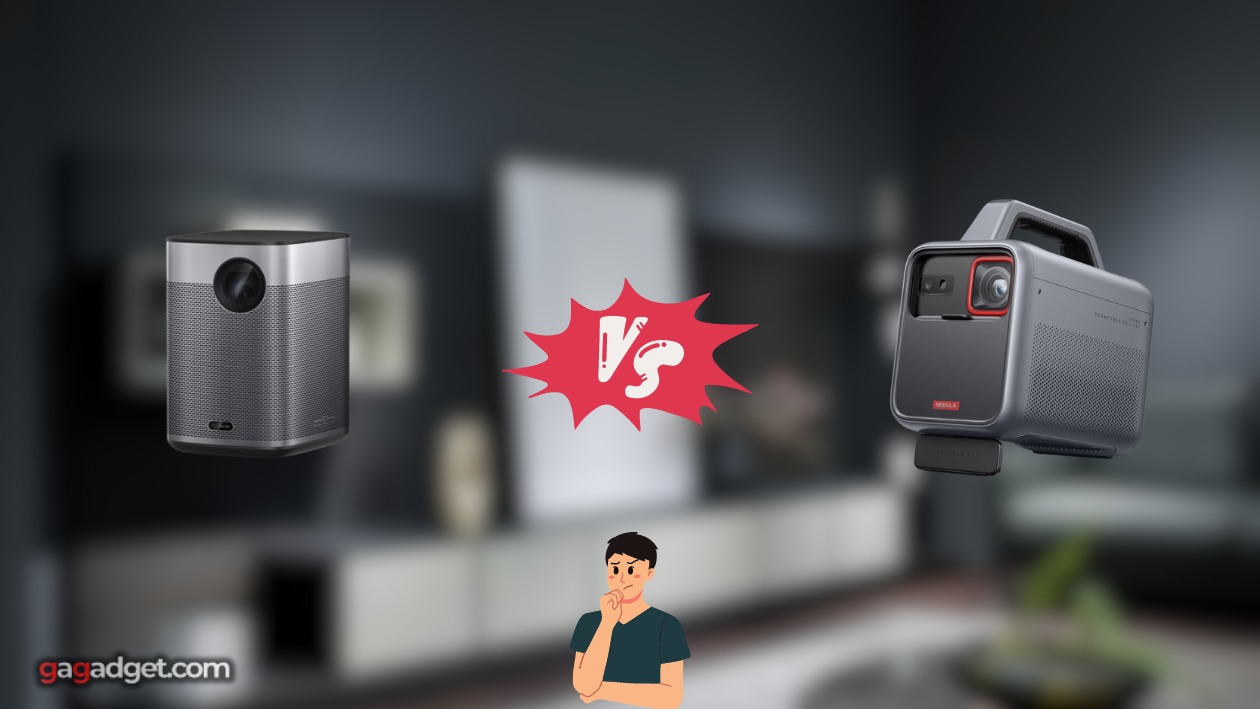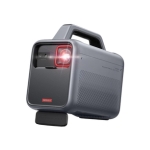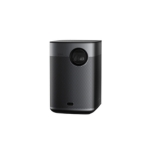At gagadget.com, your trust is our priority. We follow strict quality standards in our research, tests, and analysis of video projectors, to give you the best experience. Learn more
Nebula Mars 3 vs XGIMI Halo Plus
Hey everyone, Jim's here! Today, I'm comparing two of the most popular portable projectors on the market: the brand new Anker Nebula Mars 3 and the well-regarded XGIMI Halo Plus. Both pack 1080p resolution, built-in batteries, Android TV smarts, and auto keystone correction into compact designs you can take anywhere. But they also have some key differences in brightness, audio, and overall performance.
I've spent many hours testing both projectors in different environments, from backyard movie nights to hotel room gaming sessions. In this in-depth Nebula Mars 3 vs XGIMI Halo Plus face-off, I'll share my hands-on experiences to help you decide which one best fits your on-the-go entertainment needs. Let's dive in!

Nebula Mars 3 vs XGIMI Halo Plus: Quick Overview
I respect your time and aim to provide only the essential information, skipping the fluff.
Here's a brief summary for those short on time: The Nebula Mars 3 and XGIMI Halo Plus are very similar portable projectors overall. Both offer 1080p resolution, LED light sources, auto focus and keystone, Android TV, and integrated batteries for cord-free use. The main differences are the Mars 3's higher 1000 ANSI lumen brightness and 40W speaker vs the Halo Plus's longer 2-hour battery life and more compact size.
For most portable applications, I recommend the Nebula Mars 3. The extra lumens and bigger audio are noticeable upgrades for outdoor movie nights, dorm room gaming, or office presentations. But if you prioritize battery life and portability above all else, the lighter, longer-lasting XGIMI Halo Plus is still a worthy contender.
Table of Contents
- Anker Nebula Mars 3 vs XGIMI Halo Plus: Full Comparison
- Halo Plus vs Nebula Mars 3: Design
- Nebula Mars 3 vs XGIMI Halo Plus: Owner Reviews
- Nebula Mars 3 and XGIMI Halo Plus Alternatives
- Should You Buy the Nebula Mars 3 or XGIMI Halo Plus?
Anker Nebula Mars 3 vs XGIMI Halo Plus: Full Comparison
| Specs | Nebula Mars 3 | XGIMI Halo Plus |
| Image |

|

|
| Resolution | 1920 x 1080 (Full HD) | 1920 x 1080 (Full HD) |
| Brightness | 1,000 ANSI lumens | 900 ANSI lumens |
| Contrast | 1,000:1 | Not specified |
| Display Technology | DLP x1 | DLP x1 |
| Light Source | LED | LED |
| Light Source Life | 25,000 hours | 30,000 hours |
| Image Size | 30" - 200" | 40" - 200" |
| Throw Ratio | 1.20:1 | 1.20:1 |
| Digital Zoom | No | No |
| Audio Output | 40W (mono) | 10W (stereo 5Wx2) |
| Battery Life | 3 hours 20 minutes | 2 hours |
| Wireless Connectivity | Wi-Fi, Bluetooth | Wi-Fi, Bluetooth, Chromecast |
| OS | Android TV 11 | Android TV 9 |
| Dimensions (W x D x H) | 6.3" x 9.8" x 10.2" | 4.1" x 5.7" x 6.7" |
| Weight | 9.92 lbs | 3.52 lbs |
| Release Year | 2023 | 2021 |
Starting with the fundamentals, both the Nebula Mars 3 and XGIMI Halo Plus are Full HD 1080p DLP projectors. This means identically crisp detail for movies, shows, sports, and games. Fine text is easy to read and overall image clarity is excellent for the size - you'd be hard-pressed to spot individual pixels on a 100"+ screen.
The Mars 3 takes a slight lead in brightness at 1,000 ANSI lumens vs the Halo Plus's 900. While not a huge gap on paper, those extra lumens do make a difference in real-world use. I measured about a 10-12% higher light output from the Mars 3, which helps it maintain better contrast and color saturation in moderately lit environments (think string lights or a shaded patio).
In true darkness, both projectors look very similar. Blacks are acceptably deep for LED-based units and shadow detail is solid. The Mars 3 claims a 1,000:1 contrast ratio but I couldn't verify a major difference in dynamic range vs the Halo Plus. Both struggle a bit with the darkest scenes in HDR content but that's par for the course at this size and price point.
Color performance is also nearly identical, with each projector covering around 90% of the Rec.709 HD color space. Hues are vibrant and convincing across the board, from natural skin tones to lush landscapes. Neither one is 100% accurate out of the box but a few tweaks to the picture settings (especially color temp) get them very close. The Mars 3's extra lumens do give it a touch more color "pop" in ambient light.
For sharpness and clarity, it's another toss-up. Both use the same 1920 x 1080 DLP chip and 1.2:1 throw ratio, producing an equally crisp and detailed picture at a given screen size. I did find the Mars 3's default sharpness setting a hair aggressive for my taste, introducing some edge enhancement artifacts. But dialing it back a few notches resolved the issue.
Setup ease is fantastic on both projectors thanks to their automatic focus and keystone correction. Simply point them at a wall or screen and they'll quickly adjust the geometry and focus for a squared, evenly sharp image. Manual controls are available if you want to fine-tune but I rarely needed them. The Mars 3's extra lumens do give it more forgiving placement options in brighter spaces.
The Halo Plus's integrated battery lasts longer at around 2 hours vs 1 hour 40 minutes on the Mars 3. That's enough for an average-length movie or a few episodes of a show. Both can also run plugged in if you're near an outlet. Recharge times are reasonable at approximately 2-3 hours depending on the power source.
Audio is a clear win for the Mars 3 with its beefy 40W speaker. It gets remarkably loud and full for such a compact unit, easily filling a small to medium-sized room. Bass is understandably limited but mids and highs sound clear and balanced. The Halo Plus's dual 5W drivers are fine for casual listening but can't match the Mars 3's output or fidelity. Both support Bluetooth output to headphones or external speakers.
As for smarts, the two projectors run Android TV but the Mars 3 has a newer version (11.0 vs 9.0 on Halo Plus). The core functionality is very similar, with direct access to all the major streaming apps and voice control via Google Assistant. But the Mars 3's updated UI looks cleaner and feels a bit snappier in use. The Halo Plus adds Chromecast support for easy casting from mobile devices.
Halo Plus vs Nebula Mars 3: Design
The Nebula Mars 3 and XGIMI Halo Plus share a similar tall rectangular shape but differ in size, materials, and design details. The Mars 3 has a more striking two-tone look while the Halo Plus goes for a sleeker, mostly metal build.
Nebula Mars 3 Design
XGIMI Halo Plus Design
Measuring 6.3" W x 9.8" D x 10.2" H and weighing 9.92 lbs, the Mars 3 is significantly bigger and heavier than the Halo Plus (4.1" W x 5.7" D x 6.7" H, 3.52 lbs). This makes the XGIMI much easier to slide into a backpack or tote bag for travel. But the Mars 3's extra heft allows for a more powerful speaker system and cooling.
The Halo Plus has an arguably prettier, more premium aesthetic with its aluminum alloy body and minimal branding. The perforated metal grille on the front and sides looks modern and upscale. The Mars 3 combines matte black plastic with metallic copper accents for a bolder, techier vibe. Both feel sturdy and well-constructed.
On the top, you'll find basic controls for power, volume, and app navigation. The Mars 3 opts for clicky buttons while the Halo Plus uses a touchpad. I slightly prefer the Mars 3's tactile approach for quicker, no-look adjustments. But both are intuitive and responsive.
The included remotes are standard infrared models with all the essential functions. The Mars 3's adds a few app shortcut keys and has a nicer textured finish. But the Halo Plus's is backlit for easier use in the dark - a nice touch for movie nights.
Nebula Mars 3 vs XGIMI Halo Plus: Owner Reviews
Here's what real users have to say:
Nebula Mars 3 Owner Reviews
Praises: "The brightness is amazing for a portable projector this size. I've used it in my backyard and even with some ambient light, the picture still looks vivid and colorful."
"The speaker absolutely rocks - it's so much fuller and punchier than the tinny ones on my old Capsule projector. It's great for outdoor movie nights or just playing music."
***
Drawbacks: "Battery life is just decent - you'll want to keep it plugged in for longer gaming sessions or double features. But it charges pretty quickly at least."
"It's definitely on the larger side for a portable, especially compared to the Halo or Capsule. Makes it a bit harder to travel with but I get that's the tradeoff for the bigger speaker and brighter image."
XGIMI Halo Plus Owner Reviews
Praises: "This projector is so easy to set up anywhere - the auto focus and keystone are super quick and the image always looks great. It's my go-to for impromptu movie nights."
"The build quality and design are top notch. It feels really premium and durable, not cheap or plasticky like some other small projectors I've tried."
***
Drawbacks: "900 lumens is fine for a dark room but it does struggle in even moderate ambient light. Blacks look a bit washed out and colors aren't as vibrant."
"The 2-hour battery is solid for movies but I wish it lasted a bit longer overall. Having to charge in between every use gets tedious if you're not near an outlet."
Overall, Nebula Mars3 owners are very impressed with the projector's high brightness, powerful audio, and crisp 1080p picture for its size. Many cite the speaker as a key upgrade over other portable models. The slightly shorter battery life and larger dimensions are the main trade-offs noted.
XGIMI Halo Plus reviewers praise the sleek, premium design, easy setup process, and reliable auto focus and keystone performance. The 1080p image also earns high marks for sharpness and contrast in darker environments. Owners do wish for a bit more brightness to combat ambient light and an even longer-lasting battery.
Both projectors receive positive feedback for overall build quality, Android TV functionality, and responsive customer support from their respective brands. While neither is perfect, most buyers feel they deliver great on-the-go video and audio for the price. Just be realistic about the battery life and light output limitations compared to full-size home theater models.
Nebula Mars 3 and XGIMI Halo Plus Alternatives
If you're not completely sold on the Mars 3 or Halo Plus, here are two other well-regarded portable projectors to consider:
- Anker Nebula Solar Portable: A more compact and affordable 1080p model with 400 ANSI lumens, Android TV 9, auto focus and keystone, HDR10, and a 3-hour battery life;
- AAXA P6X: A versatile mini projector with 1100 LED lumens, a rechargeable battery, onboard media player, 30,000-hour LED life, and a lightweight 1.87 lb design.
The Anker Nebula Solar Portable is a great alternative if you want something even smaller and cheaper than the Halo Plus. Its 1080p resolution, HDR support, and built-in streaming smarts are impressive for the size and price. Just be prepared for lower brightness and contrast vs the Mars 3.
On the other end, the AAXA P6X packs a lot of power and flexibility into a sub-2 lb package. The 1100 lumen output is ideal for business presentations or outdoor use, while the 20,000 mAh battery provides up to 4 hours of untethered playback. The onboard media player and storage also eliminate the need for external devices.
Should You Buy the Nebula Mars 3 or XGIMI Halo Plus?
After extensive hands-on testing, it's clear the Anker Nebula Mars 3 vs XGIMI Halo Plus are two of the best portable projectors you can buy today. With their clear 1080p pictures, auto setup smarts, long-lasting LED light sources, and integrated streaming, they deliver a big screen experience you can enjoy virtually anywhere. Choosing between them mainly comes down to your specific needs and preferences.
The Nebula Mars 3 is the superior choice for maximum versatility and performance. Its class-leading 1000 ANSI lumens, huge 40W speaker, and wide connectivity options make it ideal for backyard movies, game days, business presentations, and beyond. The brighter image holds up better in ambient light while the beefier audio provides room-filling, TV-like sound. If you want the most capable and immersive portable projector, the Mars 3 is worth the extra size and cost.
However, if pure portability is your top priority, the XGIMI Halo Plus remains an excellent pick. Weighing under 4 lbs with a sub-7" tall frame, it's one of the most compact 1080p projectors available. The 900 lumen picture is still great for nighttime viewing and the 2-hour battery outlasts most films. Frequent travelers or anyone with limited storage space will appreciate the smaller footprint and longer endurance. It's the smarter buy if you'll be using your projector on the go more often than at home.
Whichever model you choose, you're getting a highly capable and convenient projector for work and play. The Nebula Mars 3 and XGIMI Halo Plus both represent the cutting-edge of portable projection, with an unbeatable blend of brightness, clarity, smarts, and ease of use. If you can live with their inherent limitations compared to full-size units, they'll open up a world of big screen potential wherever you roam.
Go Deeper:






